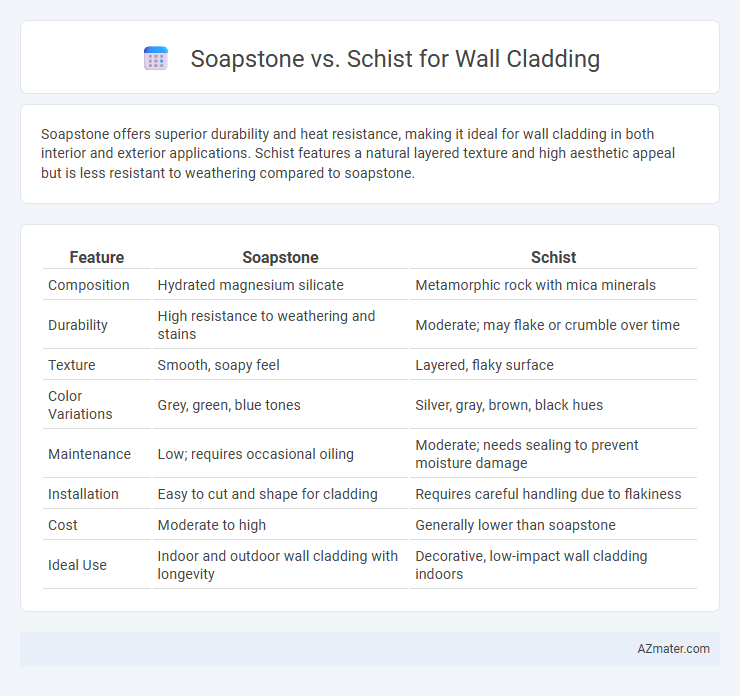Soapstone offers superior durability and heat resistance, making it ideal for wall cladding in both interior and exterior applications. Schist features a natural layered texture and high aesthetic appeal but is less resistant to weathering compared to soapstone.
Table of Comparison
| Feature | Soapstone | Schist |
|---|---|---|
| Composition | Hydrated magnesium silicate | Metamorphic rock with mica minerals |
| Durability | High resistance to weathering and stains | Moderate; may flake or crumble over time |
| Texture | Smooth, soapy feel | Layered, flaky surface |
| Color Variations | Grey, green, blue tones | Silver, gray, brown, black hues |
| Maintenance | Low; requires occasional oiling | Moderate; needs sealing to prevent moisture damage |
| Installation | Easy to cut and shape for cladding | Requires careful handling due to flakiness |
| Cost | Moderate to high | Generally lower than soapstone |
| Ideal Use | Indoor and outdoor wall cladding with longevity | Decorative, low-impact wall cladding indoors |
Introduction to Soapstone and Schist
Soapstone is a metamorphic rock primarily composed of talc, known for its softness, heat resistance, and smooth texture, making it ideal for wall cladding in both interior and exterior applications. Schist, another metamorphic rock characterized by its foliated texture and abundant mica content, offers durability and a striking, layered appearance suitable for decorative cladding. Both materials provide unique aesthetic and functional properties, with soapstone favored for its heat retention and schist valued for its natural sheen and structural strength.
Geological Origins and Composition
Soapstone, primarily composed of talc, chlorite, and dolomite, originates from metamorphic processes impacting ultramafic rocks, resulting in a soft, heat-resistant surface ideal for wall cladding. Schist forms through medium- to high-grade regional metamorphism, characterized by abundant mica minerals like biotite and muscovite, creating a foliated texture that offers durability and aesthetic appeal for cladding applications. Both stones' geological origins influence their physical properties, with soapstone's smooth feel contrasting with schist's pronounced foliation, affecting installation and maintenance.
Aesthetic Differences: Color and Texture
Soapstone offers a smooth, matte finish with soft, muted tones ranging from pale gray to deep green, creating a subtle and elegant appearance for wall cladding. Schist features a more pronounced texture with visible mineral grains and a layered, foliated structure, displaying a broader color palette including silver, brown, and gold hues that add dynamic visual interest. The natural veining and reflective mica in schist provide a shimmering effect, contrasting with the consistent, silky surface of soapstone.
Durability and Performance Comparison
Soapstone offers exceptional durability, with high resistance to heat, moisture, and chemical damage, making it ideal for long-lasting wall cladding in various environments. Schist, while also durable, tends to be more prone to weathering and may require additional sealing to maintain its performance over time. Both stones provide unique aesthetic appeal, but soapstone generally outperforms schist in terms of longevity and maintenance needs for wall cladding applications.
Weather Resistance: Indoor vs Outdoor Use
Soapstone exhibits superior weather resistance compared to schist, making it ideal for outdoor wall cladding due to its low porosity and excellent moisture absorption resistance. Schist, while visually appealing with its foliated texture, is more prone to weathering and requires sealing for outdoor applications, thus better suited for indoor use or protected exterior areas. The durability of soapstone under harsh weather conditions ensures longevity without significant degradation, whereas schist may experience flaking and erosion over time when exposed to the elements.
Installation Processes and Challenges
Soapstone offers easier installation for wall cladding due to its softer texture, allowing for simpler cutting and shaping with basic tools, while schist requires more advanced tools and expertise due to its hardness and layered composition. Challenges with soapstone include its susceptibility to scratches and the need for sealing to prevent staining, whereas schist poses difficulties in achieving a uniform surface and secure anchoring because of its flakiness and tendency to cleave along layers. Proper substrate preparation and the use of specialized adhesives or mechanical fasteners are crucial for both materials to ensure durability and stability in wall cladding applications.
Maintenance and Longevity
Soapstone offers exceptional durability and low maintenance for wall cladding, resisting stains and requiring minimal sealing compared to schist. Schist, while aesthetically versatile with its layered texture, demands more frequent upkeep to prevent weathering and maintain its structural integrity. Both materials provide long-lasting solutions, but soapstone's natural density ensures superior longevity with less intensive care.
Cost Factors and Budget Considerations
Soapstone generally costs more than schist due to its durability, ease of maintenance, and unique smooth texture, which often justifies its higher price for premium wall cladding projects. Schist offers a more affordable option with natural cleavage and layered appearance, suitable for budget-conscious installations without compromising aesthetic appeal. Budget considerations should include not only initial material costs but also long-term maintenance and installation expenses, where soapstone's resilience may provide greater value over time.
Environmental Impact and Sustainability
Soapstone, known for its durability and natural heat resistance, offers a low environmental impact due to its minimal processing requirements and long lifespan, reducing the need for frequent replacements in wall cladding applications. Schist, a foliated metamorphic rock with varying mineral compositions, can have a moderate environmental footprint depending on quarrying methods and transportation emissions; however, its abundant availability supports sustainable sourcing practices. Both materials are recyclable and biodegradable, making them environmentally friendly choices when selected with responsible extraction and installation techniques.
Best Applications for Soapstone vs Schist Wall Cladding
Soapstone is ideal for wall cladding in areas exposed to moisture and heat due to its non-porous nature and excellent heat resistance, making it perfect for kitchens and bathrooms. Schist, with its foliated texture and natural cleavage, is best suited for decorative exterior walls and accent features where a rugged, natural stone appearance is desired. Both materials offer durability, but soapstone's stain resistance outperforms schist in high-traffic indoor applications.

Infographic: Soapstone vs Schist for Wall Cladding
 azmater.com
azmater.com